Disneyland – Anaheim, California
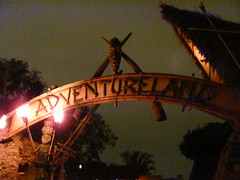 The spirit of adventure awaits beyond the entry gate illuminated by the flickering of tiki torches, beckoning explorers into the heart of the uncharted jungles of Africa and Southeast Asia. I sometimes consider Adventureland my favorite of the Disney lands to simply walk around and explore. The pathways are narrower and more intimate, the dense forestation simultaneously provides shade while keeping the field of view nearby, and overall the land is the richest in visual texture of any of Disney’s themed environments. Yet despite the abundance of real trees and natural building elements, the area also seems nearly as cartoonish as Fantasyland, presented as an amalgamation of popular fiction drawing equal inspiration from the African Queen and Around the World in 80 Days. The 1930’s throwback setting in a colonial British outpost,
The spirit of adventure awaits beyond the entry gate illuminated by the flickering of tiki torches, beckoning explorers into the heart of the uncharted jungles of Africa and Southeast Asia. I sometimes consider Adventureland my favorite of the Disney lands to simply walk around and explore. The pathways are narrower and more intimate, the dense forestation simultaneously provides shade while keeping the field of view nearby, and overall the land is the richest in visual texture of any of Disney’s themed environments. Yet despite the abundance of real trees and natural building elements, the area also seems nearly as cartoonish as Fantasyland, presented as an amalgamation of popular fiction drawing equal inspiration from the African Queen and Around the World in 80 Days. The 1930’s throwback setting in a colonial British outpost,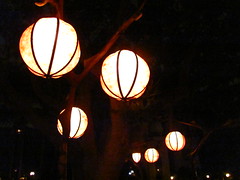 with often comical and sometimes politically questionable props and set pieces, makes Adventureland more of a meta-narrative on the West’s fascination with The Other, rather than a literal simulation of tropical environments. At night the forests come alive as the orange flickering lights dance across the foliage, the contrast between light and dark the most vivid anywhere in Disneyland.
with often comical and sometimes politically questionable props and set pieces, makes Adventureland more of a meta-narrative on the West’s fascination with The Other, rather than a literal simulation of tropical environments. At night the forests come alive as the orange flickering lights dance across the foliage, the contrast between light and dark the most vivid anywhere in Disneyland.
Adventureland, particularly its long-storied centerpiece attraction the Jungle Cruise, is perhaps the most emblematic of the hyperrealist aesthetic. It uses almost all real materials to create an encounter with something that is almost entirely artificial. The Jungle Cruise is a Disneyland original, opening with the park in 1955. Casting off from a remote outpost of the Jungle Navigation Company,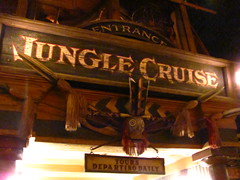 our skipper navigates our miniature steamer through a Best-Of remix of the world’s most exotic locales, apparently leaping across entire oceans without our noticing as one scene near Cambodia’s Angkor Wat is followed up by another within the piranha-infested Amazon river basin. In place of living animals are a multitude of animatronic replicas, augmenting a real safari by ensuring the star inhabitants are always ready to snap their jaws at the exact right moment, rather than sleeping or hiding behind a rock as one would disappointingly find on an actual jungle cruise.
our skipper navigates our miniature steamer through a Best-Of remix of the world’s most exotic locales, apparently leaping across entire oceans without our noticing as one scene near Cambodia’s Angkor Wat is followed up by another within the piranha-infested Amazon river basin. In place of living animals are a multitude of animatronic replicas, augmenting a real safari by ensuring the star inhabitants are always ready to snap their jaws at the exact right moment, rather than sleeping or hiding behind a rock as one would disappointingly find on an actual jungle cruise.
Rather than any individual species or landmark, perhaps the cruise’s most famous attribute is the jokey spiel the skippers recite as they lead us through the attraction’s paces, which makes the captive audience ask of themselves if there exists such a thing as a good pun. The Jungle Cruise as first envisioned by Walt Disney featured a scripted spiel that tried to make the attraction believably realistic, not unlike a nature documentary voiceover. The humor merged into the experience over time to the point that Today’s Jungle Cruise is almost a ride-through parody of Yesterday’s Jungle Cruise, an evolution that undoubtedly has many Disney loyalists not laughing. I can understand their point. Unless you’ve got a professional comedian guiding your journey, this narration does tend to distract from the ride rather than complement it, as if the interior and exterior of the steamer exist on slightly unsynchronized planes of reality. The humor does little to humor those who wish to pretend their expedition is real, as one would surely
which makes the captive audience ask of themselves if there exists such a thing as a good pun. The Jungle Cruise as first envisioned by Walt Disney featured a scripted spiel that tried to make the attraction believably realistic, not unlike a nature documentary voiceover. The humor merged into the experience over time to the point that Today’s Jungle Cruise is almost a ride-through parody of Yesterday’s Jungle Cruise, an evolution that undoubtedly has many Disney loyalists not laughing. I can understand their point. Unless you’ve got a professional comedian guiding your journey, this narration does tend to distract from the ride rather than complement it, as if the interior and exterior of the steamer exist on slightly unsynchronized planes of reality. The humor does little to humor those who wish to pretend their expedition is real, as one would surely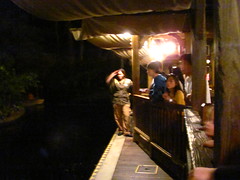 not find attacking headhunters even remotely amusing if believed to be authentic.
not find attacking headhunters even remotely amusing if believed to be authentic.
That said, the evolution toward comedy was an inevitable, perhaps necessary one. The very presence of obviously robotic animals and non sequitur geography imbues the attraction with a nervous humor born of the cognitive dissonance between supposing the absolute fake is actually the authentic reality. This situation would only be worsened if we were in the presence of a human being who seems to effuse a desire to convince us this obvious falsehood is otherwise, and so it became a necessary device to encourage guests to laugh in order to release the built-up tension caused by the contradiction of the unreality. Those that complain the humor limits the emotional depth of the experience must not realize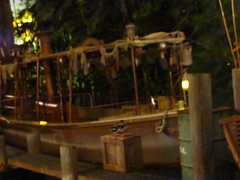 that the experience is fundamentally limited to begin with.
that the experience is fundamentally limited to begin with.
Well, maybe we should interpret the themed environment symbolically. After all, nobody literally believes the Jungle Cruise is in any way authentic. That shouldn’t matter because all representative art is also unreal, but the fact that it is a symbol for some other ideal is always genuine. Animatronic hippos and lions are meaningful interpretations of some humanistic ideal, and they contribute to a holistic narrative that’s directed on a four-dimensional living stage. It might not be Shakespeare, but it is a form of storytelling that tells us something about ourselves and the world by the end of the six minute ride time.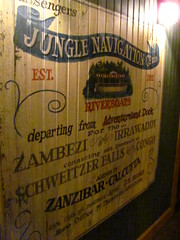
This seems like a promising defense for an argument that a more emotionally serious Jungle Cruise would be superior to the current pun-laden one. The problem is, who on earth thinks of this attraction in terms of symbolism? Symbols don’t aggressively attempt to steal the identity of the thing they symbolize. Theme parks occupy real space in real time, and there is no media filter or fourth wall that identifies the Jungle Cruise as an intentionally artistic representation. The robotic hippos aren’t just a storytelling device. They must be detailed in a way that perfectly supplants a real hippo as best as they can. There is no act of creative interpretation involved. This isn’t to say that free interpretation of the Jungle Cruise is impossible; it’s just unlikely that many people would understand it other than as literally given. Anyone that goes to Disneyland and thinks about the Jungle Cruise in terms of symbolism either holds a liberal arts degree or is French.
It would seem that if we wanted compelling narrative in a theme park attraction, we’d do much better with the additional forty years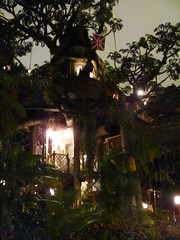 of technological and artistic development that could be found in the design of the impressive Indiana Jones Adventure: Temple of the Forbidden Eye. My hopes were high. Before even entering the queue, I speculated assertively that this would probably be one of the three best rides we’d find in the entire Disneyland Resort. This was the last major new addition to the Disneyland Park, opening in 1995 a few years before the continually ongoing California Adventure project was announced, and as such it is the most technologically advanced attraction in the original park… to say nothing of the attraction’s gargantuan size or scope. Beyond praise from technology fetishists, this attraction is often heralded for being one of the most successful examples of Disney’s mastery of nuanced storytelling technique in an attraction design. Till now I had always been rather disappointed by the results of these claims, so I was looking forward to some pretty fantastic narratology on this one. I couldn’t wait.
of technological and artistic development that could be found in the design of the impressive Indiana Jones Adventure: Temple of the Forbidden Eye. My hopes were high. Before even entering the queue, I speculated assertively that this would probably be one of the three best rides we’d find in the entire Disneyland Resort. This was the last major new addition to the Disneyland Park, opening in 1995 a few years before the continually ongoing California Adventure project was announced, and as such it is the most technologically advanced attraction in the original park… to say nothing of the attraction’s gargantuan size or scope. Beyond praise from technology fetishists, this attraction is often heralded for being one of the most successful examples of Disney’s mastery of nuanced storytelling technique in an attraction design. Till now I had always been rather disappointed by the results of these claims, so I was looking forward to some pretty fantastic narratology on this one. I couldn’t wait.
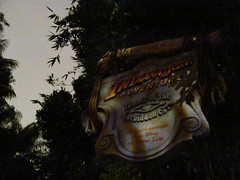 The adventure begins well before we even enter the temple, requiring a lengthy journey through a dense Bengalese rainforest filled with ruins and excavation equipment. Eventually we reach our destination, the namesake Temple of the Forbidden Eye, which begins a winding pathway through dimly lit chambers and corridors filled to the brim with hieroglyphs and defused booby traps. More so than any other ride in the Disneyland Resort, the Indiana Jones Adventure makes the establishment of mood and backstory before boarding the ride a top priority, to the degree that the attraction could lose a significant amount of value if one were to breeze right through the chambers in the FastPass or single rider queues.
The adventure begins well before we even enter the temple, requiring a lengthy journey through a dense Bengalese rainforest filled with ruins and excavation equipment. Eventually we reach our destination, the namesake Temple of the Forbidden Eye, which begins a winding pathway through dimly lit chambers and corridors filled to the brim with hieroglyphs and defused booby traps. More so than any other ride in the Disneyland Resort, the Indiana Jones Adventure makes the establishment of mood and backstory before boarding the ride a top priority, to the degree that the attraction could lose a significant amount of value if one were to breeze right through the chambers in the FastPass or single rider queues.
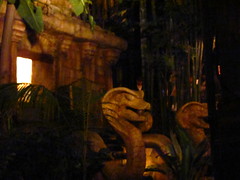 In one of the final rooms we’re presented with a short film which spells out everything that remained ambiguous up to that point. Through old newreel footage and instructional spiels from our tour guide Sallah, we learn that Dr. Jones’ discovery of the temple has become an international sensation, but more recently Jones himself has gone missing. Sallah is now conducting jeep tours through the temple to raise funds, which cleverly explains why the forbidden temple has been flooded with obnoxious tourists. Even cleverer is the subtle use of foreshadowing, as Sallah gently warns us that should we discover the idol on our tour, we must avoid looking into its eye. Oh, and also gazing into the idol’s forbidden eye is strictly forbidden. And one last thing: Beware the eye of the idol!
In one of the final rooms we’re presented with a short film which spells out everything that remained ambiguous up to that point. Through old newreel footage and instructional spiels from our tour guide Sallah, we learn that Dr. Jones’ discovery of the temple has become an international sensation, but more recently Jones himself has gone missing. Sallah is now conducting jeep tours through the temple to raise funds, which cleverly explains why the forbidden temple has been flooded with obnoxious tourists. Even cleverer is the subtle use of foreshadowing, as Sallah gently warns us that should we discover the idol on our tour, we must avoid looking into its eye. Oh, and also gazing into the idol’s forbidden eye is strictly forbidden. And one last thing: Beware the eye of the idol!
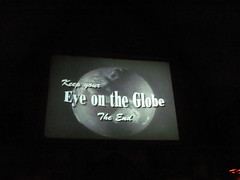 We are reminded of this about once every thirty seconds. Gee, you don’t suppose that’s going to be important later, do ya?
We are reminded of this about once every thirty seconds. Gee, you don’t suppose that’s going to be important later, do ya?
Certainly the stakes are high as we climb aboard our Enhanced Motion Vehicle (EMV), fastening our seatbelts and waiting for the all-clear to enter the temple doors. We’re about to embark on a high-speed, turbulent tour in search for a lost idol, and should anyone on board cross glances with the eye for even a split second, we’ll be engulfed in a raging hellfire and doomed to eternal damnation. I can’t even imagine the insurance policy Sallah must have taken out for this tour company.
Our vehicle kicks into gear, with yours truly behind the wheel in the driver’s seat (yep, we’re doomed), and we thunder around a right-hand bend into the Chamber of Destiny, which is – never mind, too late to explain it, we’re already barreling through the doors and – damn, this temple evidentially does not want to waste our time! Twenty seconds into the tour we’ve already located the idol without even trying. Of course having been berated by the preshow ad nauseum I was dutiful in averting my eyes, but you know there’s always going to be some joker in your car who has to sneak a peek and ruin it for everybody. The idol growls its disapproval as we round another corner and… well, there’s the final remaining mystery from the preride backstory conveniently solved for us in the first thirty seconds: the whereabouts of Dr. Jones.
in the driver’s seat (yep, we’re doomed), and we thunder around a right-hand bend into the Chamber of Destiny, which is – never mind, too late to explain it, we’re already barreling through the doors and – damn, this temple evidentially does not want to waste our time! Twenty seconds into the tour we’ve already located the idol without even trying. Of course having been berated by the preshow ad nauseum I was dutiful in averting my eyes, but you know there’s always going to be some joker in your car who has to sneak a peek and ruin it for everybody. The idol growls its disapproval as we round another corner and… well, there’s the final remaining mystery from the preride backstory conveniently solved for us in the first thirty seconds: the whereabouts of Dr. Jones.
“You had to look, didn’t you?” he yells as he tries to prop shut a door from evil forces on the other side.
“Hey, don’t be sarcastic with me!” I shout back. “Blame one of these other worthless fuckwads on my tour!”
One thing that became abundantly clear very early in the attraction was that the sense of dramatic timing was atrocious. The sudden transition from quiet, contemplative exposition that’s maintained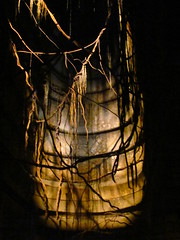 all the way up to the station, to white knuckle hell on wheels with John William’s iconic soundtrack cranked all the way to eleven, is an extremely jarring emotional shift that left me more confused than surprised. If there were supposed to be any plot developments or rising action before the big climatic turning point of the idol discovery, I couldn’t notice them, and I’d like to think I’m looking a lot harder than 99% of people that go through this ride. This haste to cut directly to the main action sequence is perhaps necessary for vehicle blocking reasons, but I was left feeling deflated rather than elated. With the two big plot mysteries resolved in the first thirty second (discovering the Forbidden Eye and finding Indiana Jones) I was already turning apathetic toward the rest of the story. The motivating action from the exposition hadn’t been defined beyond those two developments, and uncertain where the plot was supposed to go next I was released from the narrative hook before the action even had a chance to cook. Of course now it’s clear we have to escape from the temple, but my intuitive reaction in this case was literally, “that’s not going to be hard, just put this sucker in reverse and we’ll be back out the entrance in twenty yards.”
all the way up to the station, to white knuckle hell on wheels with John William’s iconic soundtrack cranked all the way to eleven, is an extremely jarring emotional shift that left me more confused than surprised. If there were supposed to be any plot developments or rising action before the big climatic turning point of the idol discovery, I couldn’t notice them, and I’d like to think I’m looking a lot harder than 99% of people that go through this ride. This haste to cut directly to the main action sequence is perhaps necessary for vehicle blocking reasons, but I was left feeling deflated rather than elated. With the two big plot mysteries resolved in the first thirty second (discovering the Forbidden Eye and finding Indiana Jones) I was already turning apathetic toward the rest of the story. The motivating action from the exposition hadn’t been defined beyond those two developments, and uncertain where the plot was supposed to go next I was released from the narrative hook before the action even had a chance to cook. Of course now it’s clear we have to escape from the temple, but my intuitive reaction in this case was literally, “that’s not going to be hard, just put this sucker in reverse and we’ll be back out the entrance in twenty yards.”
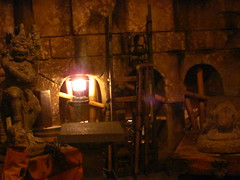 Even though I’m driving that’s not an option I’m given, and instead we must randomly crash into one scene after another before the ride arbitrarily decides it’s over. What accounts for the remaining 90% of the Indiana Jones Adventure isn’t fundamentally different from any other dark ride shtick: there is a series of unrelated props and gags. The causal relationship between these is not clear, and what exactly we’re trying to accomplish with the plot at this point is even vaguer. It’s just an opportunity to have a series of “neat” technical effects, and to make people jump and squeal several times. All the while our car is bumping and rocking around over “uneven” terrain, an effect that’s supposed to signify this attraction as a top class thrill ride. These Enhanced Motion Vehicles are probably very expensive pieces of technology
Even though I’m driving that’s not an option I’m given, and instead we must randomly crash into one scene after another before the ride arbitrarily decides it’s over. What accounts for the remaining 90% of the Indiana Jones Adventure isn’t fundamentally different from any other dark ride shtick: there is a series of unrelated props and gags. The causal relationship between these is not clear, and what exactly we’re trying to accomplish with the plot at this point is even vaguer. It’s just an opportunity to have a series of “neat” technical effects, and to make people jump and squeal several times. All the while our car is bumping and rocking around over “uneven” terrain, an effect that’s supposed to signify this attraction as a top class thrill ride. These Enhanced Motion Vehicles are probably very expensive pieces of technology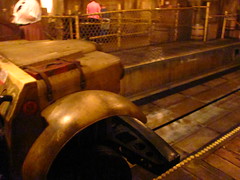 that took years to develop and would require a million nerd photos if ever given a backstage tour, but during the actual ride they enhanced little besides a sense of motion sickness. The problem was probably caused by my vantage point in the front row, where I could clearly see at all times that the road ahead of me was completely flat and paved with a little guide slot down the middle, which resulted in conflicting sensory data between my eyes and my inner ear.
that took years to develop and would require a million nerd photos if ever given a backstage tour, but during the actual ride they enhanced little besides a sense of motion sickness. The problem was probably caused by my vantage point in the front row, where I could clearly see at all times that the road ahead of me was completely flat and paved with a little guide slot down the middle, which resulted in conflicting sensory data between my eyes and my inner ear.
The story gives you all the basic flavors of everyone’s favorite death traps so that no one feels left out. There’s a mummy chamber, a bug chamber, a skeleton chamber, a rat chamber, and a snake chamber, which I suspect exists only so the sound clip of Indy’s famous quip about snakes could be used. The snake is a gigantic, ten-foot tall, 50-foot long cobra. That’s not scary. I don’t know why people think that taking creepy things and magnifying them ten times larger makes them ten times creepier. The psychology of a phobia of large animals is completely different from a phobia of small animals, and I think (evolutionarily speaking) smaller is more effective. Besides, the fact that it was painted a glow-in-the-dark purple and green pretty glaringly destroyed any lingering suspension of disbelief by that point.
More interesting is the central temple chamber, which has tall vaulted ceilings and deep crevices, which we cross through multiple times throughout the journey. The most effective trick is an excursion on a rope bridge dangling over a fire pit when the Enhanced Motion Sickness Vehicle’s engine stalls out, and a large stone god at the far end shoots lasers out of his eyes in an attempt to destroy the bridge; though for an omnipotent deity on his home turf he’s not a very good shot. The positive aspect of this central design feature is that it puts the adventure on a grander scale, expanding the field of vision far beyond what we’re accustomed to for an indoor theme park dark ride. The down side is that it makes it easier to trace the route of the dark ride path into and back out of the various gag chambers, and we can even see other EMSVs at different points on their journey, reminding us that our adventure is in no way unique.
After a couple minutes of non-stop Enhanced Motion Sickness rampage we finally slow down as we approach a long corridor. Our vehicle hesitates for an extended second, and the music even cuts out. For me this moment of silence actually became the most memorable trick in the entire ride, because it was the only time when there was ever a variation in pacing, psychologically suggesting that something was about to happen, rather than something always happening. The gag at the payoff was not particularly worth it; it was a blowdart chamber that triggered a hundred puffs of air, ineffective because the sound effects suggested projectiles that were large and slow enough that they could be partially witnessed with the naked eye, and that we should all be dead by the time we reach the end, requiring our imaginations to fill in the rest of the incomplete effect. Oh well, it was still one of the better tricks on offer.
Now how on earth are they possibly going to top a showstopper that literally involves stopping the car for two seconds and a bunch of compressed air tanks? Tricky, I know, but those clever designers can always think of something, and at this point I realize we’re probably getting close to the point when we’re running out of budget and need wrap up the freeflowing regurgitation of noise and action and tack an unrelated conclusion on the end that will convince people Disney Imagineers are still master storytellers. Rounding the next corner, we come face to face with our hero dangling from a rope, and he informs us he has a bad feeling about this.
He is right. It seems the Forbidden Eye has doomed us to eternal recurrence, that pataphysical condition where we are cursed to relive our lives an infinite number of times with no remembrance of our previous, identical fates. A giant boulder rushes towards Indy and our EMSV, with apparently no one realizing this is exactly the same event as what previously happened in Raiders of the Lost Ark. A chilling climax indeed.
With seemingly nowhere to go, our EMSV drops down a previously hidden descent at the last second before geological annihilation. This was the one trick that still has me gasping “how did they do that,” as it somehow involved reversing the vehicle and releasing an opening in the track. At the bottom of this drop and around the last curve we encounter one last fake Harrison Ford wiping his brow next to a crumbled boulder, which doesn’t quite make sense because the spatial relations between scenes don’t completely add up. The transition between rooms is supposed to play the same function as a cinematic cut between scenes, and this intention is generally understood by riders, but because we’re occupying real four-dimensional space it doesn’t quite gel as naturally as on film. There is a strong intuition that this Dr. Jones is not the same as that previous Dr. Jones because, well, they’re not.
I also am left wondering how the heck Indy escaped from the boulder. This crucial plot point that distinguishes a happy ending from a tragic ending is left totally unexplained. Potentially another failure at adequately linking causation between dark ride scenes, it seems that after a hundred million dollars in research and development, the best resolution to the story is an appeal to an ironically uncommented upon deus ex machina device. Indiana Jones is unshaken by his improbable near-death escape and cracking casual jokes with the tourists as we’re returned to the station.
At the end of the adventure, I cannot say that I am any closer to discovering the elusive meaningful storytelling I’ve been promised and searching for in theme park rides. I disembarked genuinely confused, unconvinced that I could be feeling so much indifference towards an attraction that had so much money and talent behind it.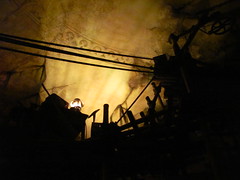
The best explanation I have for this is that the human element is completely lost amid the impossibly huge budget. At the most fundamental level, all forms of fiction and art are about the connection of one human being to another, either through the interpersonal sharing of stories or sounds or visual ideas. They took what was originally a successful cinematic idea and tried to translate it verbatim into the themed environment, not realizing what they were losing in the conversion process and doing nothing to bring it back to life in the unique dark ride medium.
On the screen you see live human actors, spontaneously reacting to the world they find themselves in. The director, cinematographer, and editor, meanwhile, are always hiding just behind us, reinforcing a continuous sense of identity as they lead us through this world along with their characters. Our perspective is their perspective, and unless we’re watching surveillance footage, in the movies we take comfort in the fact that no matter whom we’re with or what we see on screen, we are never really alone.
It’s not the same on the Indiana Jones Adventure. Here we find ourselves completely alone and isolated, our perspective shared with exactly no one but ourselves. All the other humans are either lifeless preprogrammed duplicates, droning cast members with no free will beyond serving us efficiently and with a smile, or are just as alone and confused in this vast mechanical world as we are. We share in the thrills and the laughs with others in our EMSV, but more in the way we comment on some natural event like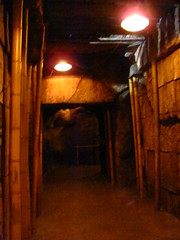 a white water rapids adventure. The attraction’s creators remain anonymously hidden behind the walls, directing the action at us but not with us. Any individual act of creative expression is muted against the vastness of the project and the requirements of the franchise.
a white water rapids adventure. The attraction’s creators remain anonymously hidden behind the walls, directing the action at us but not with us. Any individual act of creative expression is muted against the vastness of the project and the requirements of the franchise.
This natural deficiency found in recreating a cinematic environment in a real four-dimensional space could perhaps be forgiven if the story was ever compelled by anything deeper than random action and effects, but I’d be hard-pressed to mount such a defense for the Indiana Jones Adventure.
It is a tale told by an idiot, full of sound and fury, signifying nothing.
I think the Indiana Jones Tokyo DisneySea and Anaheim Disneyland rides are very much the same in the sense of the ride and feel of the ride. I enjoyed both. The EuroDisney site is apparently very different and much more like a Rollercoaster. The Euro Disney version of Indiana Jones is in Disney Sea however and it is called ‘Raging Spirits’ and it sits right next door to the Indiana Jones ride. It has had all the Indiana Jones stuff taken off and is just a roller coaster although similarly themed for the area its in. Apparently it’s a rough ride!
In my opinion, the critique expressed here about the Indiana Jones Adventure seems a little too harsh if not unjust. At the end of the day, we’re talking about a theme park ride, not Shakespeare. Anyway, there is a back story to this ride which is told in the little film playing while guests are waiting to get on, and it goes something like this: In 1935, Indy is running out of fundings to continue his excavation. In order to raise money, they are offering tours to tourists, guided by Indy’s pal Sallah. But some of these tourists looked into Mara’s eyes and got lost. In his attempt to rescue them, Indy himself disappears in the temple, and it is the task of the visitors to find him.
I think it is one of the most entertaining rides in the whole Disney franchise.